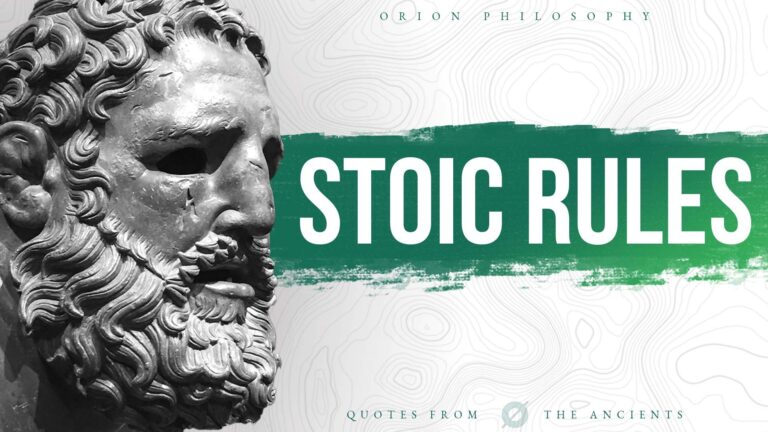The ancient Stoics are best known for their practical approach to personal philosophy and their search for ways in which we can live more happily, more resiliently, and with greater peace of mind.
To achieve this, Stoicism was a philosophy to be practiced daily, weaving seamlessly into day-to-day life and becoming a natural part of how we live. Simply put, it becomes routine.
I recently wrote about how we can develop an evening Stoic routine to help us achieve the calm resilience that can be found in the philosophy. However, today we’re going to take a look at ways in which we can incorporate Stoicism into our morning routines.
Here are four ways we can use Stoic philosophy to set us up for the day ahead:
Habit 1: Mindfulness Meditation (ProsochE)
Towards the end of his career, deep into a conflict on the borders of the Roman Empire, Marcus Aurelius began the practice of sitting down to write a personal journal, Meditations. A journal that’s now been translated and published (I’m not sure how he’d feel about that, but I’m glad we have it).
“You have power over your mind – not outside events. Realize this, and you will find strength.”
– Marcus Aurelius, Meditations
Aurelius’ use of journaling was partly a meditation practice.
For us, it can be a place where we can be honest about our thoughts, feelings, and plans. Journaling helps you reflect on your actions, understand your emotions, and set clear intentions for the day. Like wiping a foggy mirror, it brings clarity to your thoughts.
However, you don’t necessarily need to write. I do this as a mental practice, and those of you who prefer meditation to journaling can get just as much benefit from the former.
You might ask yourself:
-
What virtues do I want to reflect today?
-
What challenges might I face, and how do I want to respond to them?
-
Was there anything I did yesterday that I don’t want to do today?
-
Name a handful of things I’m grateful for
We can follow this with mindfulness:
-
Becoming aware of our breathing
-
Noticing our emotions and our thoughts
-
Increasing our awareness of the sounds, smells, and sights around us
This practice of mindfulness—often referred to as prosochē in ancient texts—is the art of living in the present moment and maintaining an awareness of our thoughts, actions, and emotions as and when they happen.
If we spend a few minutes on this every morning, we become better at naturally noticing things as we go about our day-to-day lives.

Habit 2: Practicing Gratitude
Imagine your mind as a garden. Every morning, you have the choice to take some time and plant whatever you like in the soil, changing the feel of the garden and preventing the weeds from taking over.
“Gratitude is not only the greatest of virtues, but the parent of all others.”
– Marcus Tullius Cicero
Deliberately practicing gratitude is much like planting your favorite seeds, watching them grow and bloom, and enjoying their company. When we look at the things around us and remind ourselves to be grateful for what we have or what we’ve been through, it helps us to reframe the way we think and see the world and ourselves in a more positive light.
Gratitude also helps prevent negative thoughts and feelings from taking root because we’re no longer thinking about what we don’t have or what we haven’t experienced. Instead, we’re happy for what we do have; after all, we’re surrounded by things we have now that we’d miss if they were taken from us.
“All you need are these: certainty of judgment in the present moment; action for the common good in the present moment; and an attitude of gratitude in the present moment for anything that comes your way.”
– Marcus Aurelius
Why Practice Gratitude in Stoicism?
-
Grounding Ourselves:
Gratitude can act like an anchor. It helps us stay connected to the present moment and the world around us, and it helps us appreciate the blessings we have, no matter how small they might seem. It could be the steam from a cup of coffee in the morning, the sound of leaves in the wind, a good book, a talk with a friend, or sinking into the couch to watch your favorite show. -
Shifting Perspective:
Life isn’t always easy. By focusing on what we have rather than what we lack, we transform our outlook. It’s like looking at a glass as half-full instead of half-empty. As we said above, it’s like choosing to plant the things we want instead of weeds. -
Building Resilience:
The Stoics believed in facing challenges with a calm mind. Being thankful makes our mental armor stronger, prevents us from feeling helpless or like a victim, and generally helps us handle life’s ups and downs.
If you’re the kind of person who enjoys writing a journal (discussed in Habit 1), you can add a gratitude journal to your practice. Every morning, jot down three things you’re thankful for. They don’t have to be big.
“True happiness is to enjoy the present, without anxious dependence upon the future, not to amuse ourselves with either hopes or fears but to rest satisfied with what we have, which is sufficient, for he that is so wants nothing. The greatest blessings of mankind are within us and within our reach. A wise man is content with his lot, whatever it may be, without wishing for what he has not.”
– Seneca
Habit 3: Physical Exercise (Askesis)
While exercise is clearly not a uniquely Stoic practice, it does compliment the values we’re looking to build and, if you’re anything like me, provides a needed kick to wake up properly in the morning.
“No man has the right to be an amateur in the matter of physical training. It is a shame for a man to grow old without seeing the beauty and strength of which his body is capable.”
– Socrates.
The philosopher Chrysippus was known to be a long-distance runner, the Stoic Cleanthes was a boxer, and the founder of Stoicism, Zeno of Citium, was an active merchant.
Even Plato, whom the Stoics loved, was an avid wrestler.
To these men, their philosophy was not simply theory and debate, it was something to put into practice, and exercise was an excellent compliment to the mental component of their way of life.
Through exercise, we build discipline, strength, and routine and improve both our mental and physical health.
It can be as simple as stretching or as exerting as a hard run. Whatever it is, a morning routine with exercise is almost always better than one without it.

Habit 4: Planning and Prioritizing (PhronEsis)
A Definition: The ancient Greek word ‘Phronesis’ (φρόνησῐς) is a branch of wisdom related to taking practical action towards a desired end. The principle is made up of both making sound judgments and behaving with excellence of character. The principle was a common subject of discussion in ancient Greek philosophy.
You may have already guessed that this principle is core to the practice of Stoic philosophy. The Stoics believed that wisdom was one of the four core virtues we should concern ourselves with, the others being courage, justice, and temperance.
This can be used in our morning routine to think about the day ahead and choose, ahead of time, how we wish to carry ourselves.
First say to yourself what you would be; and then do what you have to do. If evil be spoken of you and it be true, correct yourself, if it be a lie, laugh at it.
Over your morning coffee or tea, you can think of the choices you’ll face and ask yourself, “What would a wise Stoic mentor advise?”
Remember, the goal of following our own Stoic morning routine is not just to prepare for the day ahead but also to develop a resilient and focused mindset that will help you navigate life’s challenges as they present themselves day-to-day.
These practices are flexible, and you can adapt them to suit your own personal needs and circumstances.






